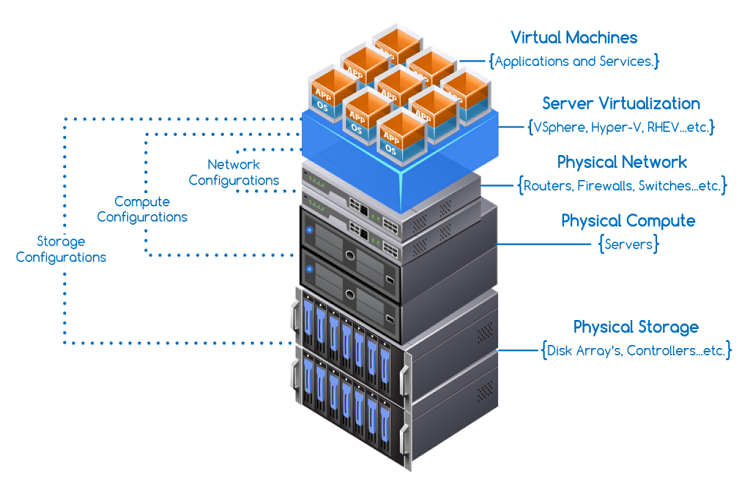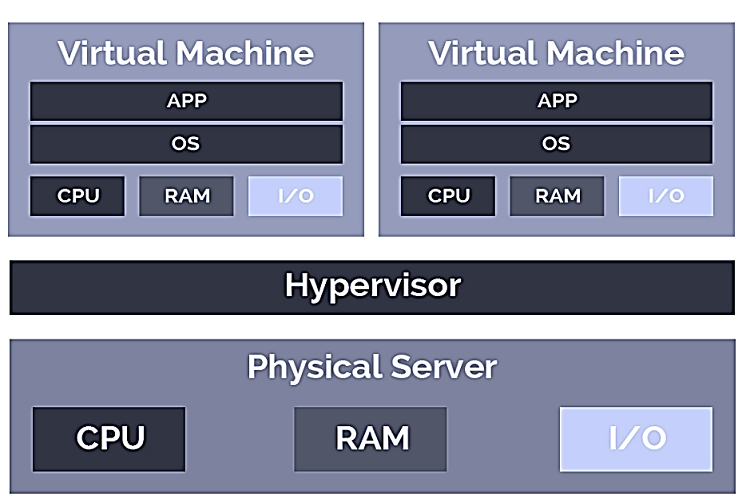
The third generation of technology convergence has plumed “Hyper Converged Infrastructure (HCI)” a scale-out software-defined architecture to dated datacenter infrastructure – SDDC. It clubs together compute, storage and network services in an accelerated industry and acclaimed logical unit to deliver scalable and minimally complex infrastructure services in a helically integrated software layer — hypervisor, delivering a plausible virtual computing engine as to the previous DC’s required operation wise tagged/ear-marked hardware/s. The advent of HCI has sent the concept of legacy DC’s to obsolescence. The SDDCI creates a simple and manageable agile and secured data protection services, high availability and VM mobility built on cloud principles and economy.
HCI consists of 3 software layers: [1] compute virtualization [2] storage virtualization and [3] network virtualization as well as service management. The virtualization software abstracts and pools the underlying resources and dynamically allocates them to applications running in virtual machines or containers. HCI enjoys a sleek new operational model which removes unnecessary redundant resources (to maintain high availability) and minimal downtime and the management of compute, storage and networking can be done in a single window. Advanced smart management features further reduce manual intervention setting a cosy recline to automate entire operation/s in a clocked managed accountability with a perpetual event logging.
HCI Physical Schema

Simplification of Operational Mundane
CIO’s seemed to invoke compute (servers) and storage (external storage arrays) resources separately and then establish an intricate connectivity between these devices to make a shift arrangement. Now each of these augmented components calls in a under par silo operational expertise (often disorganized and in dismay). With sleek manual intervention, HCI reduces such operational costs and continuum to a borderless integration of hardware and software solution/s that eliminates the complexities associated with fibre channel networks, purpose-built storage and complex LUN planning. A thin layered, converged IT team can now monitor and manage the compute and storage resources in a steadfast time, freeing IT resources to focus on other strategic priorities.
HCI Logical Schema

Total Cost of Ownership (TCO)
In-house storage arrays brim up within five years of data holding. In addition, augmentation of external arrays workout to be expensive and are often dedicated to networking performance enhancements. HCI allows businesses to lower their CAPEX expense by invoking a scale up/scale out architecture with industry-standard x86 servers. Focus will be on the compute and storage they need for a short period of time and add capacity as needed, either by adding nodes to a cluster (scale out) or storage drives to existing nodes (scale up).
Phenomena to Agile Managing
HCI can deliver a zero day support for the latest technologies, leveraging the agility to increase application performance from business-critical applications extensible to VDI, without a major infrastructure change. Because of the flash-accelerated capabilities of HCI, virtual desktop interface (VDI) and cloud native applications are common workloads due to the harnessing of high-throughput, low latency storage that scales out to context. Business-critical applications, such as relational databases have become the primary HCI usage case spectrum.
HCI
The plinth to any digital foundation construe to computing and SAN for hyper-converged infrastructure. SAN helps customers to seamlessly augment to the state-of-the-art datacenter with a transition to a high performance experience—expansibilities making HCI software choice for both in premise deployments and on to public cloud providers.
HCI Components
- Enables a virtualization platform
- Storage for virtual machines and containers/cylinders
- Integrated and scalable management solutions
HCI powered by SAN has variedness in deployment options:
- Resilient integration to multi-vendor platform
- HCI-as-a-Service from the largest HCI cloud ecosystem including top cloud providers like, Amazon, CISCO, IBM, Microsoft, Nutanix, VMware and a host of other vendors
HCI delivers:
- Edge technologies porting on diversified range of servers
- Pay for the compute slice (a shift in paradigm) to trim costs
- Simulate a native HCI encryption
- Span to virtual storage and pay for the space used only
- Distributed storage operations
- Freeing up from technology obsolescence and near zero capex investments
- Application on CaaS, PaaS, SaaS, etc.
- Seamless built up on multi-vendor cloud services
- Minimal redundancy with 99.99% of uptime
- Cutting down bottom-line expenses (TCO)
The author is Senior Manager - IT at Balmer Lawrie & Co

 In
In
Comments
Cialis 20 Mg Einnehmen [url
Cialis 20 Mg Einnehmen [url=https://buyciallisonline.com/]best place to buy cialis online forum[/url] Buy Cipro Canada <a href=https://buyciallisonline.com/#>Buy Cialis</a> Amoxicillin Stds
Where Can I Buy Tamoxifen Uk
Where Can I Buy Tamoxifen Uk https://bbuycialisss.com/ - Cialis Viagra Rosa <a href=https://bbuycialisss.com/#>buy cialis 5mg online</a> How To Buy Diclofenac Gel
Add new comment